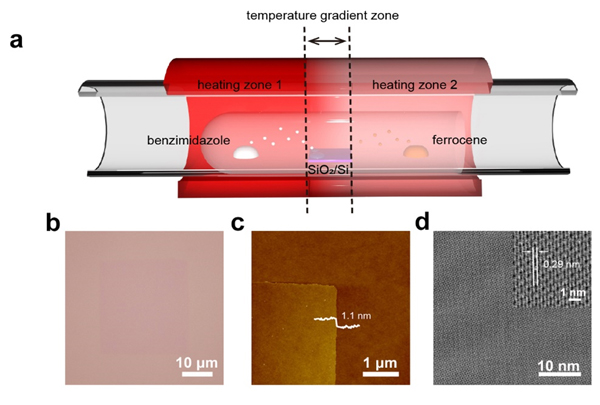Growing Atomically Thin Metal-Organic-Framework Single Crystal via Chemical Vapour Deposition
ZHENG Jian lab from the Institute of Chemistry of the Chinese Academy of Sciences has developed a new chemical vapour deposition (CVD) method to grow two-dimensional (2D) monolayer metal-organic framework (MOF) single-crystal.
2D MOFs with inherent molecular pore/cavity structures, composed of metal ions connected by organic ligands, have gained significant attention in recent years. A crucial step in exploring their properties and applications is the reliable preparation of high-quality monolayer MOF single crystals. However, the inherent fragility and strong interlayer interactions present in bulk crystals often lead to 2D MOFs with multiple layers, small sizes, and/or limited crystallinity when using existing methods.
Chemical vapour deposition (CVD) is a powerful technique for the controlled preparation of high-quality, large-area monolayer 2D materials. However, the growth of large, single-crystal, monolayer MOFs using the CVD method remains a challenge that has not been overcome until now.
In this study, the researchers have developed a self-condensation-assisted CVD (SCA-CVD) technology, which enabled them to realize, for the first time, the preparation of large-size monolayer metal-organic framework (MOF) single crystals.
During the CVD process, the researchers designed a temperature gradient to facilitate the self-condensation of the precursor into a pure liquid. This process created a temporary liquid growth environment, which significantly enhanced the free path of precursor molecules and improved the reversibility of coordination bonds. This dynamic growth environment enabled the efficient growth of large-size and high-quality monolayer metal-organic framework (MOF) single crystals. As a result, the researchers obtained monolayer Fen(bim)2n single crystals with a size of tens of microns.
The SCA-CVD method has shown good compatibility. 2D MOF single crystals could be directly grown on various substrates, even on the surface of monolayer MoS2. An ultra-thin van der Waals heterostructure of Fen(bim)2n/ MoS2 was fabricated, which demonstrates the functional integration of the precise gate effect of MOF crystals and the high sensitivity of monolayer MoS2, enabling fast and highly selective ammonia sensing.
This work has been published in Nature Communications. The study was supported by National Natural Science Foundation of China and the Chinese Academy of Sciences.

The SCA-CVD Growth and Characterizations of atomically thin Fen(bim)2n single crystals. (Image by LUO Lingxin)
Contact:
Prof. ZHENG Jian
Institute of Chemistry, Chinese Academy of Sciences
Email: zhengjian@iccas.ac.cn





